Data is the most important asset you have in your digital strategy. Collected data will get you to determine and track metrics that will further give you insights into business opportunities.
Metrics provide powerful insights into the performance of your business.
They help you make informed decisions about your operations, your marketing or sakes effirts and determine the success of your strategies.
In this article, we’ll explore opinions from experts on how to use metrics to your advantage and how they can help you improve your business.
From tracking customer satisfaction to analyzing financial performance, metrics can be used to improve almost any aspect of your business. We’ll show you how to harness the power of metrics to take your business to the next level.
So, let’s dive into expert opinions on what ecommerce metrics will improve business.
How to Use Metrics to Increase Revenue [Dmitry Nekrasov]
Metrics is a powerful tool for measuring and analyzing business performance, and they can be leveraged to increase revenue.
By tracking key performance indicators (KPIs) such as conversion rates, customer satisfaction, and sales growth, companies can gain insight into what drives revenue and make data-driven decisions to optimize their operations and boost profitability.
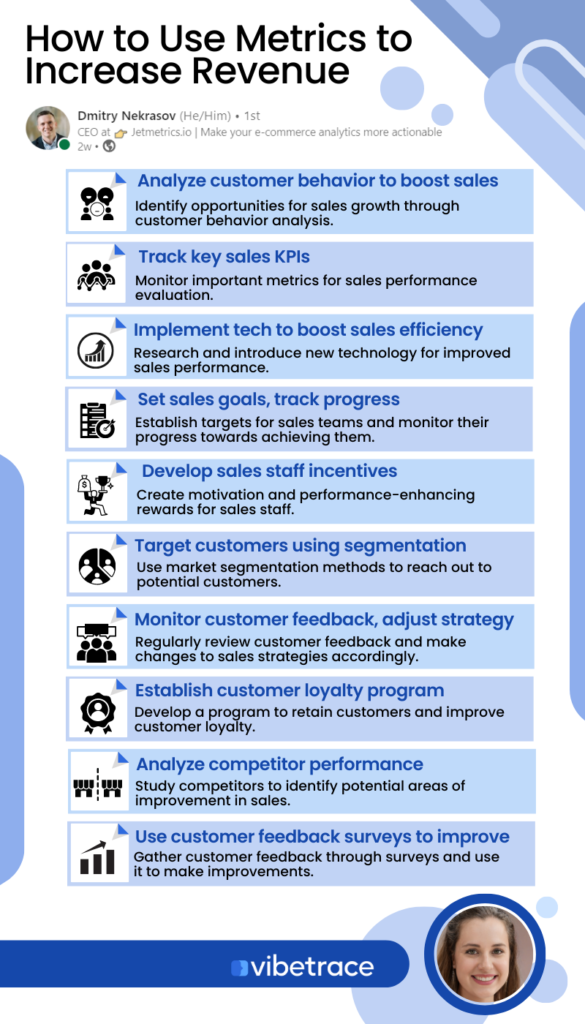
Explore the use of metrics to increase the revenue of your business and follow the provided tips according to Dmitry Nekrasov, CEO at Jetmetrics.io, for effectively tracking and interpreting data.
- Analyze customer behavior patterns to identify areas of opportunity for sales growth.
You can use metrics such as purchase frequency, average order value, and product/service usage patterns. This information can be gathered through data analysis tools, customer surveys, and transaction records.
Additionally, you can identify customer segments with high potential for upselling or cross-selling. If you notice that a particular customer segment frequently makes high-value purchases, it may be beneficial to target them with offers for premium products or services.
- Track key performance indicators such as customer lifetime value, sales conversion rate, average order value, etc.
The Customer Lifetime Value (CLV) is an estimation of the total monetary value a customer will bring to a company during their entire relationship.
The Sales Conversion Rate, on the other hand, determines the percentage of website or landing page visitors who take a specific action, such as purchasing a product or filling out a form.
Lastly, the Average Order Value (AOV) calculates the average amount spent by customers per order.
- Research and implement new technologies to improve sales efficiency.
Metrics play a crucial role in measuring the success and impact of business strategies. By tracking key performance indicators (KPIs) and analyzing customer behavior patterns, businesses can gain valuable insights into their operations and identify areas for improvement.
One way to effectively leverage metrics is by utilizing new technologies, such as online software. These tools provide real-time data and insights into important KPIs such as sales conversion rate, customer lifetime value, average order value, and more.
- Set target goals for sales teams and track progress against them.
A high or low rate for each key metric holds significance and helps to set sales goals for a business. By monitoring these metrics, it is possible to gauge the performance of the business and identify areas for improvement.
For instance, a low sales conversion rate may indicate a need for optimization of the website design, messaging or checkout process. On the other hand, a high customer lifetime value may suggest that the business is effectively retaining its customers and may benefit from increasing investment in customer engagement and retention strategies.
- Develop incentives for sales staff to increase motivation and performance.
By using metrics to track sales performance, you can motivate your sales team to achieve your company’s goals. Providing rewards and incentives for meeting or exceeding performance targets can boost employee motivation and engagement. This can help sales teams focus on the key metrics that drive business success and work towards meeting the company’s objectives.
Furthermore, regular performance tracking and recognition can foster a culture of accountability and continuous improvement, helping the sales team stay motivated and focused on achieving their goals. By using metrics as a tool for motivation, you can drive sales performance and increase revenue, while also supporting the growth and development of your sales team.
- Utilize market segmentation methods to target potential customers.
Segmenting customers can be difficult, especially if you are running a new business. But by using metrics, it becomes easier to identify targets and effectively use market segmentation to reach the desired audience. Metrics can provide insights into your customer interests, demographics, and behavior patterns, allowing you to create targeted marketing campaigns that resonate with specific segments of your audience.
By leveraging these insights, you can improve the efficiency of your marketing efforts and drive sales growth by effectively reaching your target market. Thus, using metrics as a tool to support market segmentation can be a valuable strategy for businesses looking to improve their sales performance.
- Monitor customer feedback and adjust sales strategy accordingly.
Metrics serve as a means to gauge the success of a business in various areas such as increasing sales, generating leads, attracting customers, and more. They provide a comprehensive understanding of customer behavior, enabling businesses to make informed decisions for strategic improvement.
By regularly tracking and analyzing key metrics, you can assess your business performance, identify areas for improvement, and make adjustments to drive growth and increase revenue. Hence, metrics play a crucial role in helping businesses stay ahead of the competition and succeed in their efforts to grow and improve.
- Establish a customer loyalty program to improve customer retention.
Customer loyalty programs, similar to discounts and vouchers, offer benefits to a business by helping to retain customers and encourage repeat purchases.
These programs incentivize customers to stay loyal to your brand, creating a long-term relationship that can drive repeat business and contribute to the growth and success of your company.
- Analyze competitor performance to identify potential areas of improvement.
By utilizing various metrics, your business can optimize its performance and identify areas for improvement.
Metrics provide valuable insights into the strengths and weaknesses of your business, allowing you to make informed decisions to address any shortcomings and drive growth. Thus, using metrics effectively can lead to continuous improvement and increased success of your business.
- Utilize customer feedback surveys to identify areas of improvement.
Feedback surveys simplify the process of tracking metrics and identifying areas for your business improvement. These surveys provide valuable insights into your customer opinions, experiences, and preferences, allowing you to monitor key performance indicators and make data-driven decisions to optimize your operations and drive growth.
Hence, using feedback surveys as a tool to track metrics can be an effective way for you to continuously improve and achieve success.
Do you like this article?
Join our CX for Retail dedicated newsletter!

Stay connected to what’s really important to optimize your digital revenues.
By clicking the button, you accept our Terms & Conditions. Also you will need to confirm your email address.
How to Maximize Your Return On Investment [Rory Flynn]
Email marketing is one of the most cost-effective and high-return marketing channels available, with an average ROI of 36X.
This means that for every $10,000 spent on email marketing, a company can expect to earn $360,000 in return. With this impressive return on investment, it’s important for businesses to optimize their email marketing efforts in order to maximize ROI.
As we look ahead to 2023, it’s a good time to evaluate your email marketing strategy and identify areas for optimization. To help you get started, here are 14 useful email optimizations that can help you spend less, earn more, and maximize ROI according to Rory Flynn, Head of Client Acquisition at Commerce12:
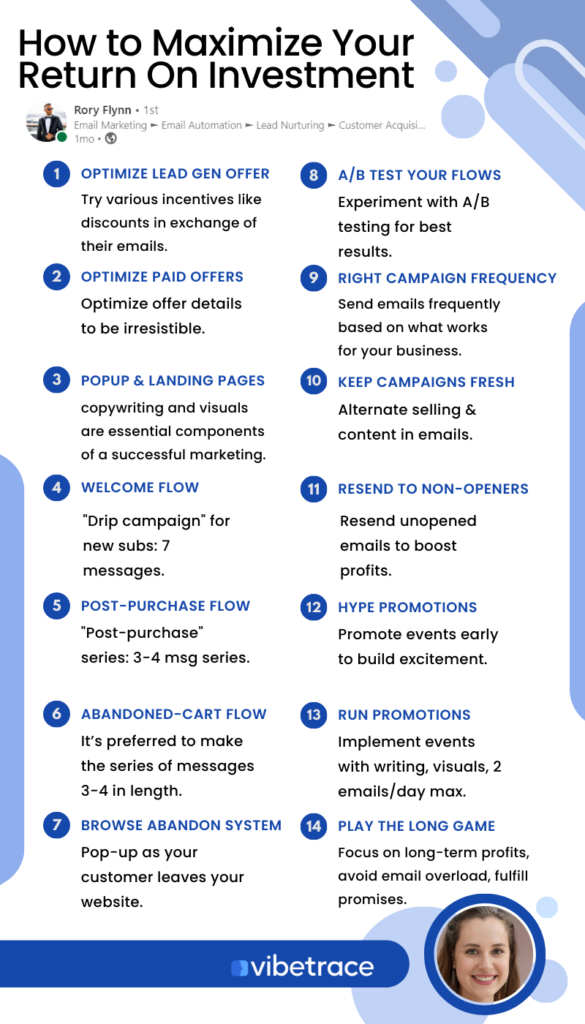
- Optimize Your Lead Gen Offer
Believe it or not, the offer you provide in exchange for an email address is much more impactful than the style or font of your sales copy. To determine what resonates most with your audience, try experimenting with various incentives such as discounts, free resources, and giveaway entries.
Analyze which offer resonates best with your customers, and use that information to drive more effective and successful email marketing campaigns.
- Optimize Your Paid Offers
The value and quality of your paid offerings are crucial to the success of your business. It is important to ensure that your customers or clients have a strong desire for the products or services you’re selling. To maximize the effectiveness of your offerings, consider refining the details such as the deliverables, refund guarantee, and other key factors until the offer becomes irresistible to your target audience.
By offering high-quality and desirable products or services, you can increase customer engagement, drive sales, and grow your business.
- A/B Test Popup & Landing Pages
While the offer itself is critical, copywriting and visuals are also essential components of a successful marketing campaign. Once you have established a winning offer, focus on making your pop-up and landing pages as compelling as possible. This can be achieved through the process of conversion rate optimization, which helps to improve the effectiveness of your marketing and increase the number of customers who take the desired action.
By incorporating persuasive copywriting and visuals, you can further enhance the impact of your marketing efforts and maximize your return on investment.
- Send A Welcome Flow To New Subs
An automated message series sent to new subscribers is referred to as a “drip campaign.” It’s preferable to have campaigns consisting of 7 messages.
The first few messages promote the lead generation offer, then you can change the approach before moving on to the next steps.
- Send A Post-Purchase Flow To Customers
Another automated message series, sent to customers after their purchase, is commonly known as a “post-purchase drip campaign.” This campaign typically consists of 3-4 messages if you want to implement it.
The messages can include your thank you to the customer for their order, offer complementary products, and attempt to generate additional sales.
- Send An Abandoned-cart Flow To Second Guessers
This automated message is sent to individuals who have left items in their online shopping carts, a common occurrence occurring in about 70% of cases.
It’s preferred to make the series of messages 3-4 in length. Additionally, you can aim to create a sense of urgency in the messages, reminding them that their saved cart will soon expire.
- Consider Creating A Browse Abandon System
The final commonly used flow is the Browse Abandonment System. This is when your store displays a pop-up as your customer leaves the website, and if they subscribe, they receive a series of messages.
You can freely implement this for your business to see if it works for you.
- A/B Test Your Flows
Success with A/B test flows may not be achieved immediately. Try to experiment with variations such as A/B testing subject lines, preview text, messaging approach, design elements, and more. Gradually refine and optimize these flows to maximize their profitability for your business.
- Find the Right Campaign Frequency
Finding the right frequency for your email campaigns is crucial to avoid burnout. Some businesses do well with just one email per week while others send three, five, or even seven.
Although, it is best to always check what could be good for your business so you won’t make your subscribers uncomfortable with tons of emails. A good starting point if you are still unsure is to send two emails per week and adjust as needed.
- Keep Your Campaigns Fresh
It’s not effective to solely sell in every email. Alternate between promoting products, sharing customer success stories, educating your audience, and other types of content. By varying your approach, you can keep your subscribers engaged and interested.
- Resend To Non-Openers
Resending emails to those who didn’t open them is a simple way to boost profits. By sending the same message a couple of days later, you increase the chances of it being opened and ultimately generate more revenue per message written.
Watch out this idea, there is a complete article on open rate.
- Hype Promotions
Maximizing your revenue during special events like sales and product launches is crucial for your business. To ensure success, it is important to start promoting these events well in advance, rather than waiting until the day of the event. Building excitement over a period of a week or two is an effective strategy..
- Run Promotions
Once you’ve generated enough excitement for your promotions, it’s time to implement them. Perfect your writing, add visuals if necessary, and send a maximum of two emails per day during the sale.
- Play The Long Game
Put the focus on long-term profits over short-term gains. Avoid bombarding subscribers with too many emails, and always fulfil promises made. By treating your subscribers with respect and delivering on your commitments, you can maintain a profitable business for years, not just a few months or weeks.
Tips on How to Boost Open Rates [Kajal Karn]
In a post by Kajal Karn, a social media manager, and strategist, believes that every business can explore the concept of email open rate and its significance.
Despite the effort put into growing your email list, a low open rate can impact your business negatively. The post has provided insights on how to boost your email open rate, ensuring that your email marketing efforts are effective and your subscribers are engaged.
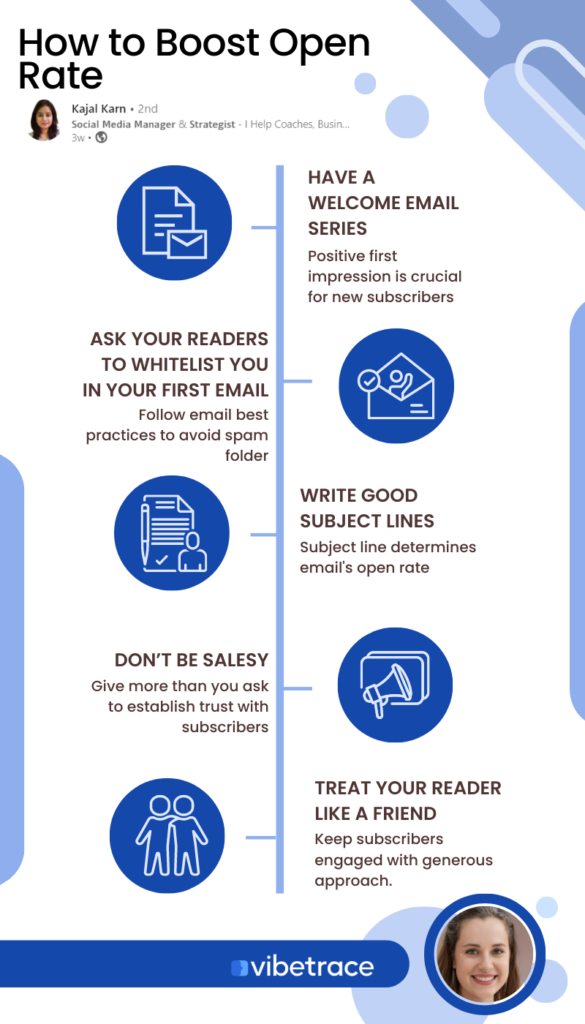
Here are 5 tips to boost your Email Open Rate:
- Have a Welcome Email Series
Making a positive first impression is very important, especially when someone has just signed up to join your mailing list through your website. This window opportunity provides a chance for you to showcase your brand’s personality and establish a connection with your new subscriber.
Time is of the essence, as you only have 24-48 hours to make a lasting impression. Maximize this opportunity by crafting a compelling Welcome Email series.
- Ask Your Readers to Whitelist You in Your First Email
To avoid your emails being marked as promotional or ending up in the spam folder, make sure to follow email best practices. Additionally, offering freebies on your website can increase anticipation for your first email and encourage subscribers to look forward to your future communications.
Who doesn’t love a good deal or a free gift right? Here’s an article on how to do it.
- Write Good Subject Lines
The subject line of your email is a determining factor in its open rate. A subject line that appears spammy or over-promising can discourage subscribers from opening your email.
It’s important to craft subject lines that are enticing but also truthful so that you can increase the chances of your email being opened and read.
- Don’t Be Salesy
When it comes to building a relationship with your subscribers, it’s important to give more than you ask for. Being generous and open-handed in your approach can help to establish trust and keep your subscribers engaged.
This applies not only to email marketing but to all aspects of your online business. If every email you send is a sales pitch, it can lead to decreased engagement and a higher likelihood of subscribers unsubscribing.
- Treat Your Reader Like a Friend
Having a personal, conversational tone in your emails can go a long way in building a relationship with your subscribers. Rather than sounding automated, try to write as though you’re speaking to a friend. Focus on speaking to each subscriber as an individual, rather than addressing a group of people.
Avoid sounding like a telemarketer who is just reading from a script, as this can be off-putting. Instead, let your unique personality shine through by being yourself—casual, funny, lighthearted, or chic. Use your voice and be authentic in your communications.
Top Metrics You Need to Track [Emmanuel Obafemi]
Avoid common email marketing mistakes by tracking the wrong metrics. A recent study shows that only 25% of emails are opened and read, potentially leading to a significant loss.
To optimize your campaigns and maximize engagement and ROI, focus on monitoring the right key performance indicators (KPIs). Here are a few KPIs to consider in 2023 according to Emmanuel Obafemi:
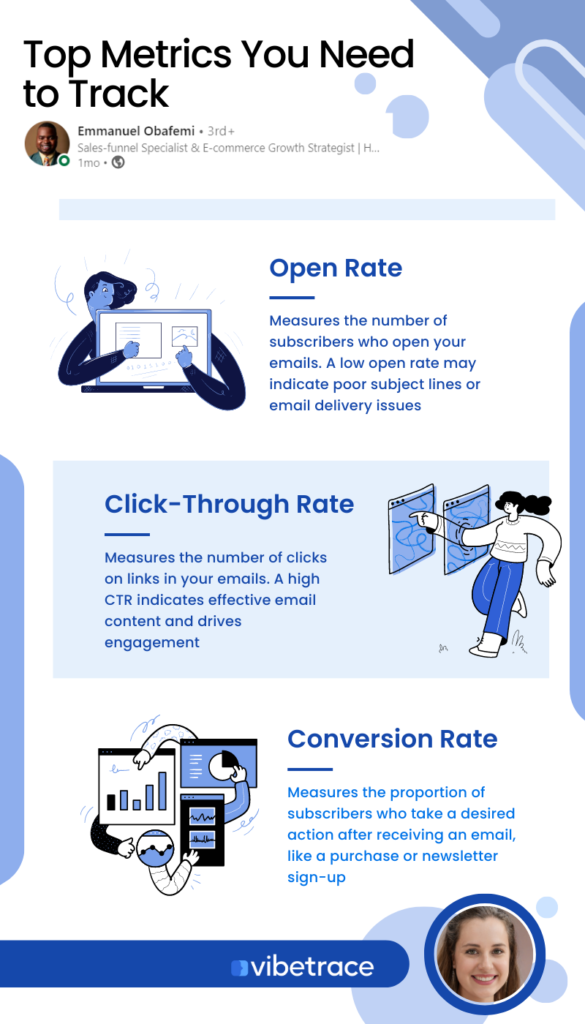
Open rate: The open rate measures the number of subscribers who open your emails. A low open rate may indicate poor subject lines or email delivery issues. To boost your open rate, apply best practices to your subject lines, such as personalization, brevity, and avoiding trigger words. Segmenting your email list to deliver more personalized messages can also improve your open rate.
Click-through rate (CTR): The click-through rate (CTR) gauges the number of clicks on links in your emails. A high CTR indicates effective email content and drives engagement. To enhance your CTR, utilize persuasive calls to action, conduct A/B testing, and incorporate social share buttons to allow subscribers to easily share your content.
Conversion rate: The conversion rate measures the proportion of subscribers who take a desired action after receiving an email, like a purchase or newsletter sign-up. Monitoring conversion rate reveals the effectiveness of your emails. To increase conversion rate, use personalized and specific messaging, offer incentives, and optimize emails for mobile.
Tracking key metrics can help you improve your email marketing strategy.
Focus on open rate, click-through rate, and conversion rate to see how well your campaigns are performing and identify areas for improvement. Get support if needed to optimize your efforts and reach success in 2023.
Start tracking these top metrics and take your email marketing to the next level!
3 Questions on Conducting Sales that Boosts AOV
Your brand must be leaving money on your business table by running sales.
Brands need a well-thought-out marketing strategy that is based on careful planning and a deep understanding of the target audience, rather than just randomly trying various marketing tactics without a clear plan or direction.
Throwing everything up against the wall and hoping that something will stick is not a sustainable or effective approach to marketing, and is likely to result in a waste of resources and a lack of meaningful results.
So, before running a sale according to Oscar Guerrero ask these 3 questions:
- Who gets to see the sale?
- What is on sale?
- Why are we having the sale?
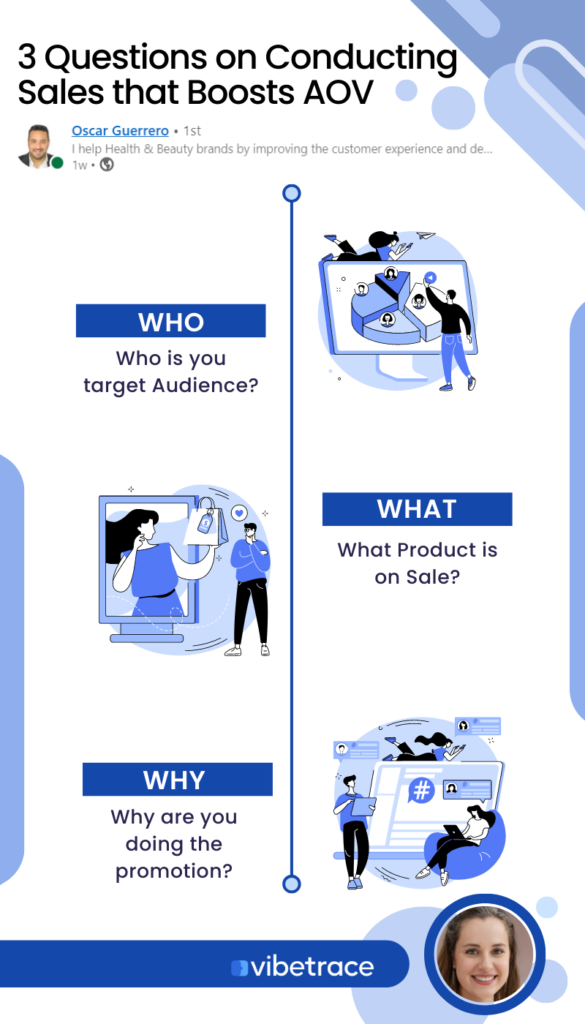
Who:
“Your Target Audience”
Consider your customer’s buying stage. First-time buyers may require motivation to overcome their hesitance. In fact, the need for an incentive may vary based on product type and cost.
For a quicker return, a discount may be necessary on the second purchase, but it depends on the product’s necessity level. Subsequent purchases may require incentives, it depends on product hierarchy and what competitors offer.
What:
“You Product Offering on Sale”
Consider options for the stale products: move at cost for cash flow, create a bundle and discount for a higher AOV, or highlight a high-margin product.
Why:
“Your Reason”
To achieve success in your marketing efforts, you need to take a strategic approach, rather than just trying different tactics without a plan. This is especially important when it comes to sales, as the way you structure them is closely tied to your customer acquisition cost, inventory levels, and forecasting.
To reach the next level, you can’t just keep relying on the same methods that haven’t been working. A successful growth strategy requires intentional planning and a focused approach, not just wishful thinking.

